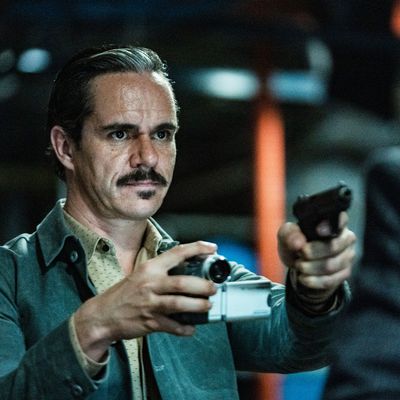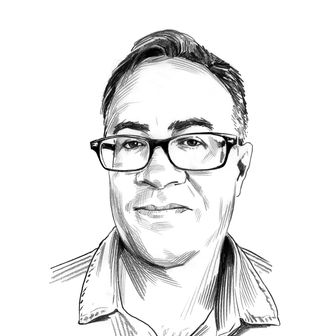
“You keep telling the lie that you’ve been telling.”
That’s Mike, counseling Jimmy and Kim about how they’re going to handle Howard’s death. They’re told that Howard’s Jaguar will be found on a beach a few states over and that his death will eventually be considered a suicide, which will seem plausible given his personal and professional setbacks. They’re told that traces of cocaine will be discovered on the upholstery, because “that’s the story you were setting up for this guy.” Breaking Bad and Better Call Saul are keyed into inflection points like this when their characters make choices that set their lives on a dark trajectory. That’s what the title Breaking Bad means, after all, or a nickname like “Slippin’ Jimmy.” The cost for Jimmy and Kim’s transgressions may be unreasonably high — there’s a sound argument that Howard had it coming, in fact, and that justice was done on behalf of his elderly clients — but they still have to pay it. They’re trapped in the tangled web their grand deception has woven.
But “Point and Shoot” doesn’t leave much time for Jimmy and Kim (much less the viewers) to marinate in these consequences. Only the cold open, with its elegant shots of Howard’s dress shoe lapping against the shoreline, offers any moment for peaceful contemplation. The rest of the episode picks up right where the mid-season finale left off — with Jimmy and Kim screaming over Lalo nonchalantly shooting Howard in the head. That moment is itself a disturbing study in contrasts: Howard means nothing to Lalo, who dispatches him with the casual swiftness of a business executive brushing lint off of his three-piece suit. But Jimmy and Kim are seeing a person they knew murdered up close, and their reaction is so piercingly human against Lalo’s serene bloodlessness. Their lives are changed forever in ways they (and we) can only begin to contemplate. Even in the little time he has left on earth, Lalo will have forgotten about it.
Despite Jimmy’s protests that he never turned on him, Lalo has settled on a plan to kill Gus, so it doesn’t really matter anyway. Lalo wants Jimmy to drive his car to Gus’s neighborhood, park down the street, grab a revolver and camera from the glove compartment, knock on the door, and shoot the docile “house cat” who’s Black and medium height with short hair. It’s a simple job that Jimmy persuades Lalo to let Kim do instead, because it seems to him like her survival is at least within the realm of possibility. What neither of them realizes is that this assassination attempt is not something Lalo actually expects to succeed; like Jimmy and Kim’s three transparent efforts to link Howard to cocaine, it’s just part of a greater ruse.
When Kim inevitably fails and gets dragged into Gus’s house by Mike and his security goons, Gus doesn’t need to hear much from her to pick up on what Lalo is doing. “Why did Lalo send you?” he asks Kim, who replies that Lalo originally wanted to send Jimmy, but Jimmy “talked him out of it.” Gus knows that Lalo isn’t the type of guy who could get talked out of anything, which signals to him that it genuinely didn’t matter to Lalo who was dispatched on this mission that was 100 percent certain to fail. Gus realizes that Kim’s mission is a ruse, part of the multidimensional chess game he’s been playing with Lalo, and that he would be on the move to another location, which Gus correctly surmises is the Lavandería Brilliante.
Although Lalo may not expect Gus to confront him in this place, it seems right that they would have to settle their conflict personally. They have too much history to allow anyone else to do the job for them. Keep in mind that Gus is the architect of an entire security apparatus — a tunnel between two houses, cameras everywhere, gunmen at multiple locations working 24/7 — and Lalo doesn’t know about any of it, so he could stay put and direct others to the Lavandería Brilliante. But the Salamancas murdered his partner Max, and as cool-headed and prudent as Gus can be in his business dealings, his fury over the incident is unfathomably intense in a way that only Giancarlo Esposito’s pinched features can express. He wants to run the meth business as pristinely as Los Pollos Hermanos’s fryer after close, but he’s as hot-blooded under the surface as the drooling, scowling, bell-ringing Hector Salamanca is on the surface.
The confrontation between Gus and Lalo is classic “Fallacy of the Talking Killer” stuff, but Lalo cannot resist the urge to make a show out of humiliating Gus on-camera before killing him, which would please Eladio, the unseen audience for his footage. Gus’s invective about the Salamancas is the high point of the episode, reminiscent of the scene in True Romance where Dennis Hopper’s character, certain that he’s about to die, uses his last words to insult his tormenter’s Sicilian roots. He calls Eladio “a greasy, bloated pimp.” He talks about keeping Hector alive so he could see his entire family buried. But here’s the most important passage, referring to the underground lab: “Jackals. That’s all you are. No vision. No patience. No thought. Stupid and impulsive! This is how I did all this. You couldn’t see it, couldn’t even conceive of it.”
This piece of monologue could be a Better Call Saul sub-tweet of other shows of its ilk, the ones that cut corners in pursuit of cheap thrills — thin, crude, artless time-wasters. That’s the thing that Gus and Walter White have in common: They’re not common drug dealers. They’re aesthetes. The idea of running and pushing substandard product into the market — in the meth business, not exactly a drug associated with quality control — makes them bristle. For Gus, the underground lab is an entrepreneurial masterstroke that takes the kind of investment and planning that’s anathema to “jackals” like the Salamancas, who are content to gobble up territory, steamroll the competition, and unleash great spasms of violence whenever necessary — or whenever the mood strikes them.
The thrilling immediacy of “Point and Shoot” deliberately tramples over any deeper contemplation of what has just happened, particularly with regard to Howard’s death. But it cleans the slate for the closing stretch of the season. The scheming around Howard and the Sandpiper Case is over. The showdown between Gus and Lalo is resolved. There will surely be fallout for Jimmy and Kim’s relationship once the dust settles and they no longer have to pretend that nothing has happened. But there are only five episodes left of Better Call Saul, and we don’t know what’s next other than which characters live to see the world of Breaking Bad. That’s exciting.
Burners
• Lalo’s death opens up a big continuity error that has surely tripped up Breaking Bad fans. Even though Lalo doesn’t appear in Breaking Bad, Jimmy/Saul references him during the second season’s eighth episode — his first appearance on the show. After Jesse’s buddy Badger is caught in a sting operation and Saul offers to represent him, there’s some concern that Saul will advise Badger to give Walt’s identity to the DEA to avoid prison. This leads Walt and Jesse to don ski masks and kidnap Saul, who wonders out loud if a man named “Lalo” sent them. He mentions “Ignacio,” a.k.a. “Nacho.” At this point in time, he needn’t have been concerned about those two.
• A funny incongruity to Mike wanting to survey Jimmy and Kim’s apartment without spooking the neighbors only to lead about ten armed men up the outside stairs. If I were a neighbor, I would be pretty spooked!
• Lalo’s instinct is to sneer condescendingly at everyone he encounters, but there is a note of admiration in his video to Eladio, in which he talks about German engineers spending ten months and using 200 pounds of explosives to carve out a lab without disturbing a laundry business in the middle of a city of a million people. All under the Salamancas’ noses too.
• Not that we should ever question Gus’s fastidiousness, but having that gun tucked away in the lab as a contingency is more a sign of narrative convenience than planning.
• A brand new, stainless-steel fridge!


